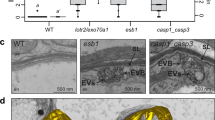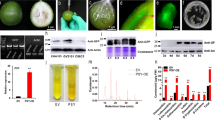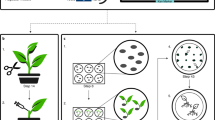Abstract
It has been found possible to achieve rapid enzymatic degradation of the cell wall of the apices of root hairs from a wide range of crop species. Thereby it is possible to expose plasma membranes with partial protoplast release whilst maintaining the functional integrity of the plant. This exposure of plasma membranes provides a port of entry into the plant for a wide range of investigations including genetic manipulations.
This is a preview of subscription content, access via your institution
Access options
Subscribe to this journal
Receive 12 print issues and online access
$209.00 per year
only $17.42 per issue
Buy this article
- Purchase on Springer Link
- Instant access to full article PDF
Prices may be subject to local taxes which are calculated during checkout
Similar content being viewed by others
References
Cocking, E.C. 1984. The use of protoplasts: potentials and progress, p. 415–425. In: Gene Manipulation in Plant Improvement. 16th Sladler Genetics Symposium. J. P. Gustafson (ed). Plenum Press, New York and London.
Davey, M.R. and Kumar, A. 1983. Higher plant protoplasts—retrospect and prospect. Int. Rev. Cytology (Suppl. 16):219–299.
Brisson, N., Paszkowski, J., Penswick, J.R., Gronenborn, B., Potrykus, I. and Hohn, T. 1984. Expression of a bacterial gene in plants by using a viral vector. Nature 310: 511–514.
Steinbiss, N.-H. and Stabel, P. 1983. Protoplast derived tobacco cells can survive capillary microinjection of the fluorescent dye Lucifer Yellow. Protoplasma 116: 223–227.
Tsukakoshi, M., Kurata, S., Nomiya, Y., Ikawa, Y. and Kasuya, T. 1984. A novel method of DNA transfection by laser microbeam cell surgery. Appl. Phys. B. 35: 1–6.
Cormack, R.G.H. 1949. The development of root hairs in Angiosperms. Botanical Review XV: 583–612.
Callaham, D.A. and Torrey, J.G. 1981. The structural basis for infection of root hairs of Trifolium repens by Rhizobium. Can. J. Bot. 59: 1647–1664.
Hornberg, C. and Weiler, E.W. 1984. High-affinity binding sites for abscisic acid on the plasmalemma of Vicia faba guard cells. Nature 310: 321–324.
Schroeder, J.I., Hedrich, R. and Fernandez, J.M. 1984. Potassium-selective single channels in guard cell protoplasts of Vicia faba. Nature 312: 361–362.
Morgan, N., Ehrenstein, G., Iwasa, K., Bare, C. and Mischke, C. 1984. Ion channels in plasmalemma of wheat protoplasts. Science 226: 835–838.
Cocking, E.C. 1960. A method for the isolation of protoplasts and vacuoles. Nature 187: 927–929.
Senn, A. and Pilet, P.E. 1980. Isolation and some morphological properties of maize root protoplasts. Z. Pflanzenphysiol. 100: 299–310.
Lloyd, C.W. 1983. Helical microtubular arrays in onion root hairs. Nature 305: 311–313.
Belford, D.S. and Preston, R.D. 1961. The structure and growth of root hairs. J. Exptl. Bot. 12: 157–168.
Cooper, K.M. 1982. Callose-deposit formation in radish root hairs, p. 167–184. In: Cellulose and Other Natural Polymer Systems. R. Malcolm Brown Jr (ed.). Plenum Press, 167–184.
Bhuvaneswari, T.V., Turgeon, B.G. and Bauer, W.D. 1980. Early events in the infection of soybean (Glycine max L. Merr.) by Rhizobium japonicum. 1. Localization of infectable root cells. Plant Physiol. 66: 1027–1031.
Davey, M.R. and Cocking, E.C. 1972. Uptake of Rhizobium by isolated plant protoplasts. Nature 239: 455–456.
Davey, M.R. and Power, J.B. 1975. Uptake of microorganisms by plant protoplasts. Plant Sci. Lett. 5: 269–274.
Hamlyn, P.F., Bradshaw, R.E., Mellon, F.M., Santiago, C.M., Wilson, J.M. and Peberdy, J.F. 1981. Efficient protoplast isolation from fungi using commercial enzymes. Enzyme Microb. Technol. 3: 321–325.
Itoh, T., O'Neil, R.M. and Brown, R.M. 1984. Interference of cell wall regeneration of Boergesenia forbesii protoplasts by Tinopal LPW. a fluorescent brightening agent. Protoplasma, 123: 174–183.
Jones, L.E., Hildebrandt, A.C., Riker, A.J. and Wu, J.H. 1960. Growth of somatic tobacco cells in microculture. Amer. J. Bot. 47: 468–475.
Author information
Authors and Affiliations
Rights and permissions
About this article
Cite this article
Cocking, E. Protoplasts from Root Hairs of Crop Plants. Nat Biotechnol 3, 1104–1106 (1985). https://doi.org/10.1038/nbt1285-1104
Received:
Accepted:
Issue Date:
DOI: https://doi.org/10.1038/nbt1285-1104



